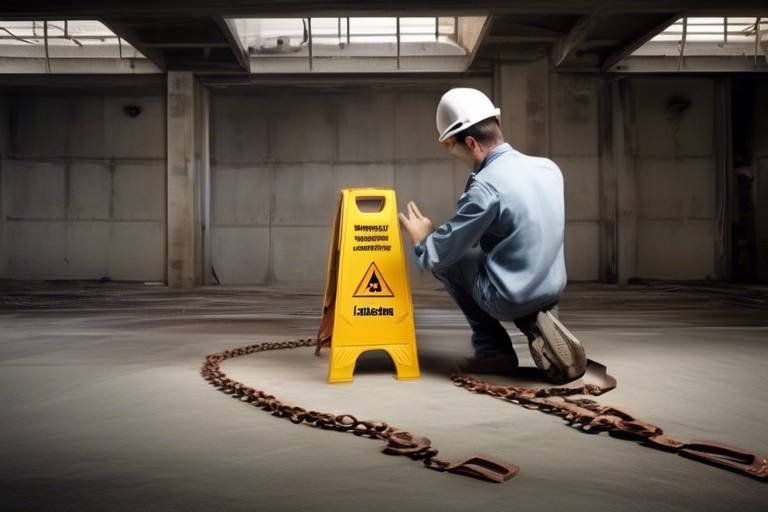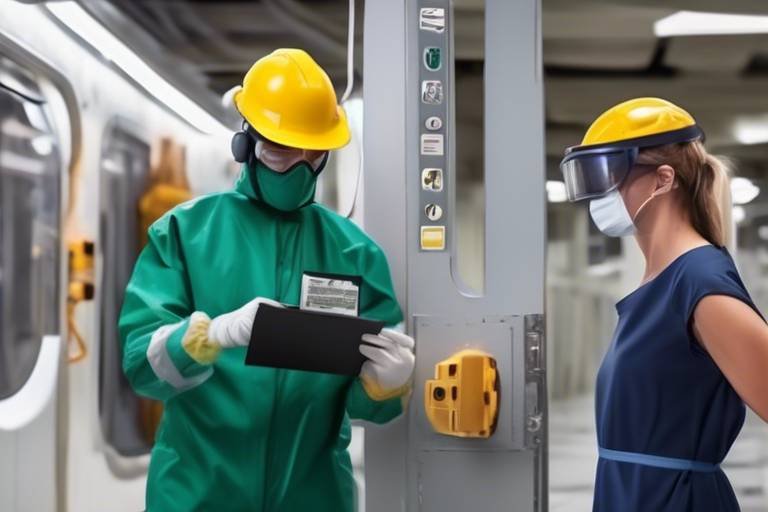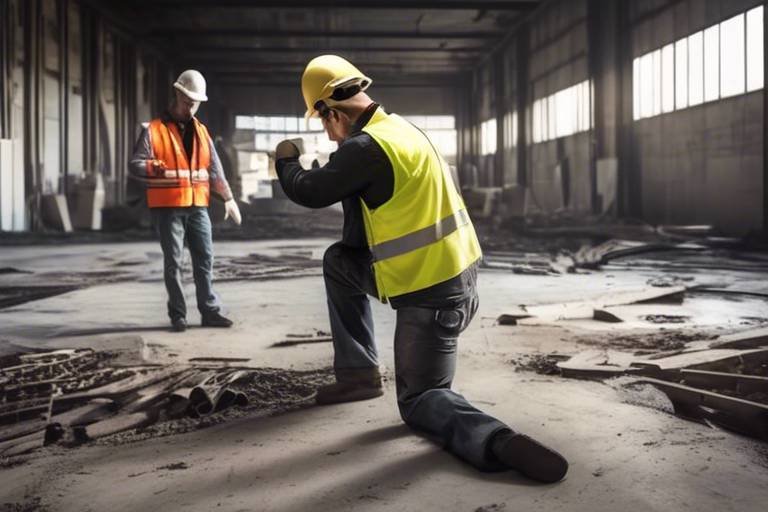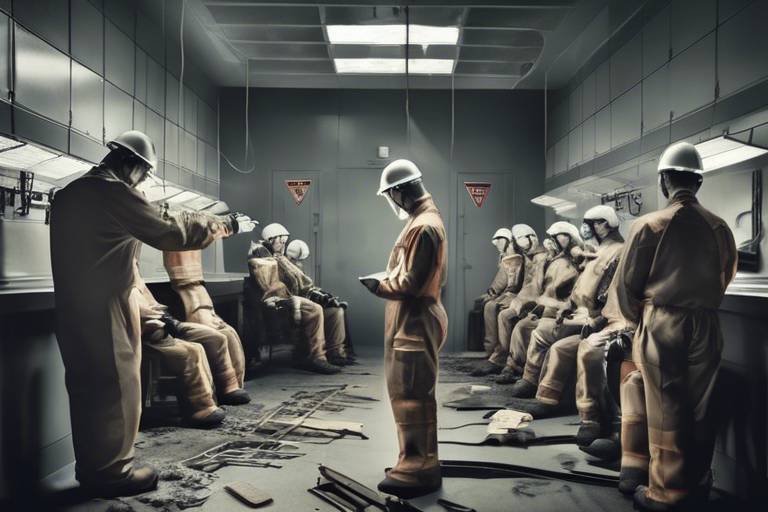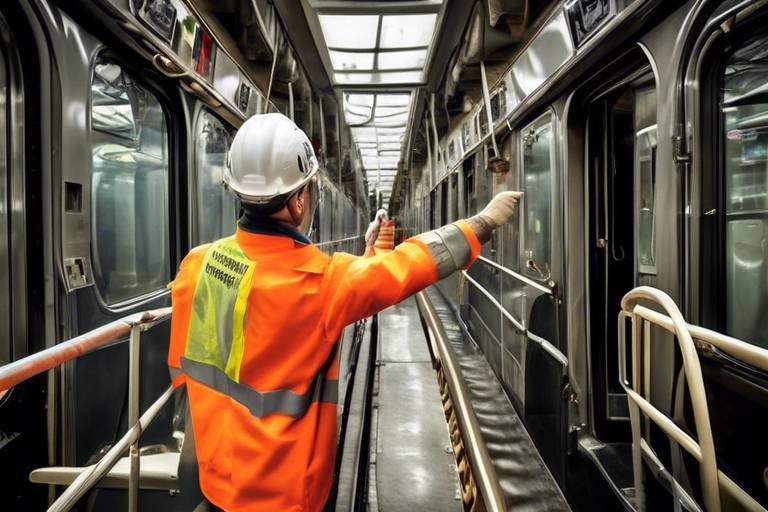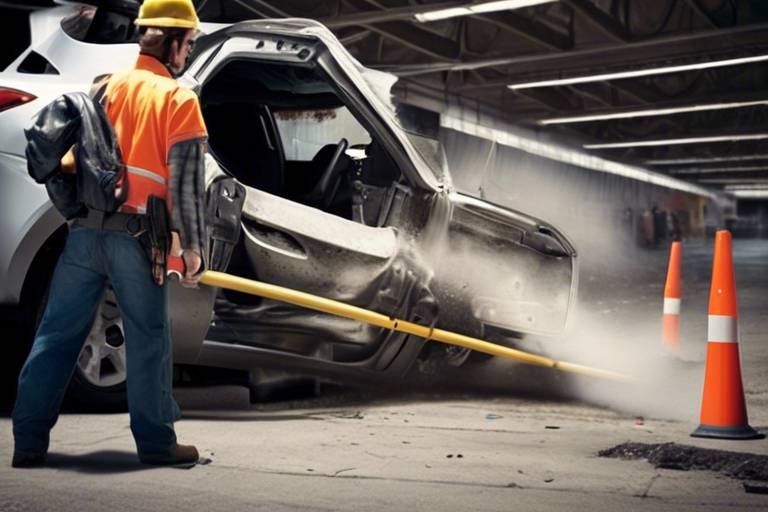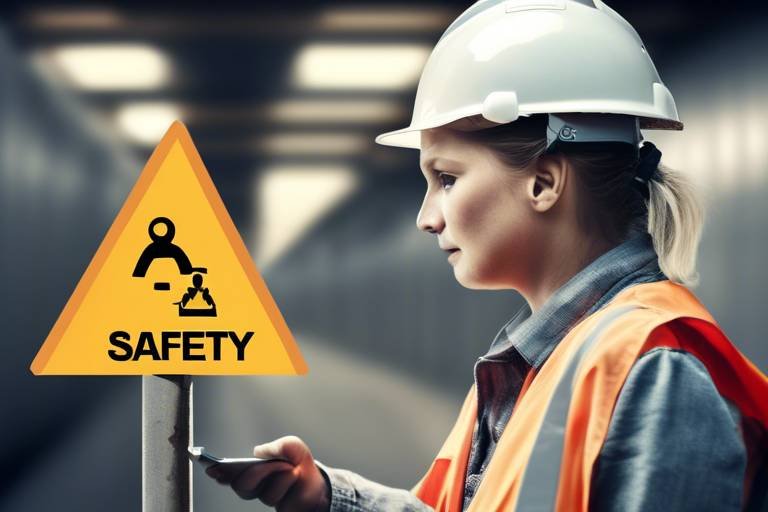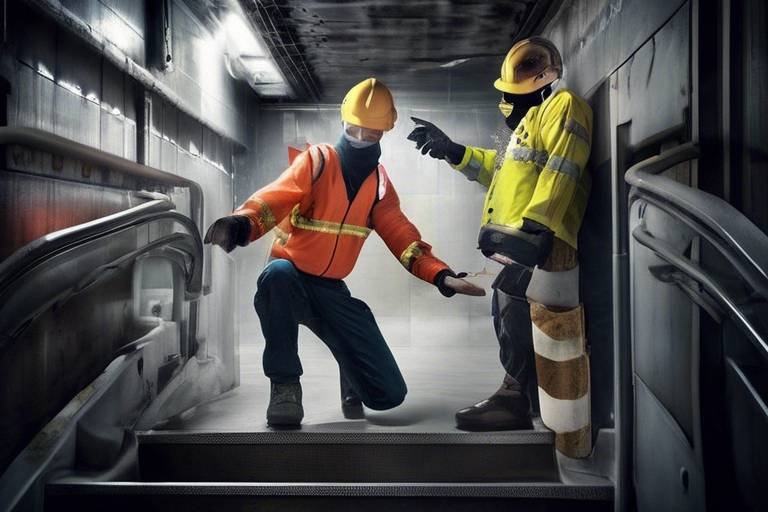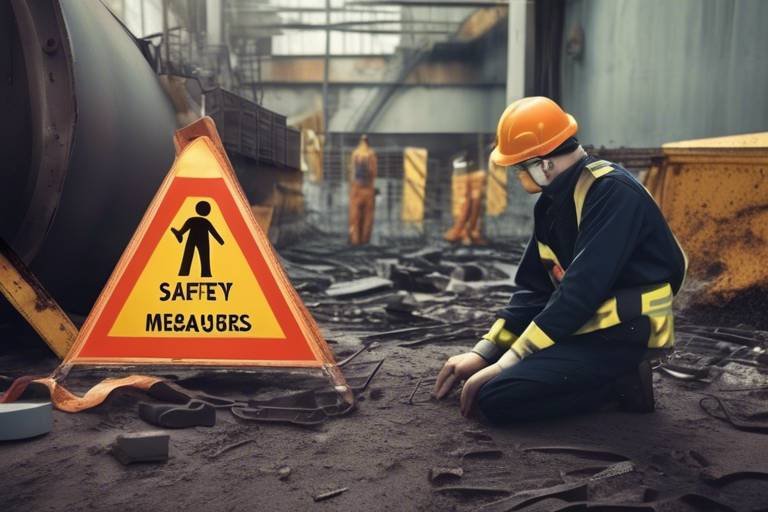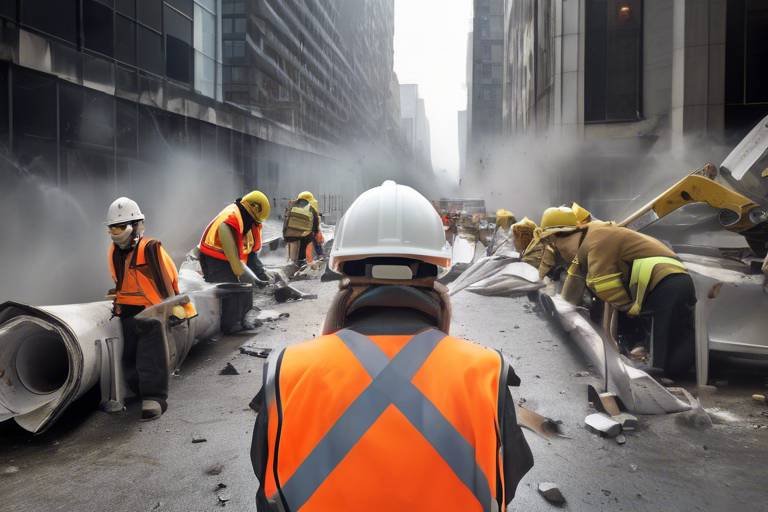Defining Safety Standards through the Understanding of Human Behavior
In today’s fast-paced world, the interplay between human behavior and safety standards is more critical than ever. As industries evolve, so too does the need for safety protocols that not only meet regulatory requirements but also resonate with the people they aim to protect. Understanding human behavior is not just a luxury; it’s a necessity. By diving deep into the psychological underpinnings of how individuals perceive risk and make decisions, we can craft safety standards that are not only effective but also embraced by those who must follow them.
Imagine walking into a construction site where safety gear is scattered and protocols are ignored. What’s the first thing that comes to mind? Danger, right? But what if we understood why workers were ignoring safety measures? Perhaps it’s not just negligence; it could stem from a lack of awareness, overwhelming cognitive load, or even social pressures. By addressing these underlying factors, we can redefine safety standards to better align with human behavior, making them more intuitive and effective.
One of the most fascinating aspects of this relationship is how cognitive biases shape our perception of risk. For instance, the optimism bias leads individuals to believe that negative events are less likely to happen to them compared to others. This can result in a dangerous complacency regarding safety measures. On the other hand, emotional factors, like fear or anxiety, can skew risk assessments, causing individuals to either overreact or underreact in critical situations. By understanding these psychological influences, we can tailor safety protocols that resonate on a human level, ultimately leading to safer environments.
Furthermore, the design of safety protocols must consider the reality of human error. Accidents often occur not because individuals disregard safety but due to genuine mistakes or lapses in judgment. The types of errors—whether they are slips, lapses, or mistakes—can be significantly reduced with well-designed safety systems. For instance, implementing clear signage, user-friendly equipment, and straightforward procedures can minimize confusion and enhance compliance. The goal is to create an environment where safety is second nature, not an afterthought.
In essence, redefining safety standards through the lens of human behavior is about more than just compliance; it’s about creating a culture of safety where individuals feel empowered and responsible. This approach not only protects lives but also fosters a sense of community and shared purpose within organizations. As we delve deeper into the psychological aspects of safety, we uncover a wealth of opportunities to innovate and improve, ensuring that safety standards are not only effective but also embraced by all.
- Why is human behavior important in safety standards?
Understanding human behavior allows us to create safety protocols that resonate with individuals, making them more effective and widely accepted. - What role do cognitive biases play in risk perception?
Cognitive biases can distort how individuals assess risks, leading to either complacency or excessive fear, which can impact safety compliance. - How can organizations improve safety culture?
By fostering open communication, involving employees in safety discussions, and providing effective training, organizations can cultivate a strong safety culture. - What are some common types of human error in safety contexts?
Common errors include slips, lapses, and mistakes, all of which can be mitigated through clear protocols and user-friendly systems.

The Psychology of Risk Perception
This article explores the intricate relationship between human behavior and safety standards, emphasizing how insights into psychology can enhance safety protocols and practices across various industries.
Understanding how individuals perceive risk is crucial for developing effective safety standards. Risk perception isn’t just about the actual danger; it’s a complex interplay of cognitive biases, emotional responses, and social influences. Imagine walking through a dark alley—your brain kicks into high gear, weighing the potential threats against your instincts. This is the essence of risk perception, where what we feel often overshadows the reality of the situation.
One of the most significant factors influencing risk perception is cognitive bias. These biases can distort our understanding of risks, leading us to overestimate or underestimate dangers. For instance, the availability heuristic suggests that we judge the probability of events based on how easily examples come to mind. If we frequently hear about airplane crashes, we might irrationally believe that flying is more dangerous than it actually is, despite statistics showing it's one of the safest modes of transport.
Emotional factors also play a pivotal role. When we feel anxious or scared, our perception of risk can skyrocket. This emotional response can lead to overprotective behaviors or, conversely, to reckless decisions if someone feels invulnerable. It's a bit like driving too fast because you feel confident in your skills, ignoring the real risks involved. Recognizing these emotional triggers is essential for creating safety protocols that resonate with people on a deeper level.
Additionally, social influences cannot be overlooked. Our perceptions of risk are often shaped by the opinions and behaviors of those around us. If a colleague dismisses safety protocols, it may lead others to follow suit, creating a culture of complacency. On the other hand, when safety is prioritized and modeled by leaders, it can foster a stronger commitment to safety standards among all employees.
To better understand these dynamics, consider the following factors that influence risk perception:
- Personal Experience: Past experiences can heavily influence how we perceive risk. Someone who has been in a car accident may view driving as far more dangerous than someone who has never had such an experience.
- Media Influence: The portrayal of risks in the media can amplify fears. Sensationalized news reports about safety failures can lead to heightened perceptions of risk.
- Peer Influence: The behaviors and attitudes of peers can significantly shape individual perceptions of risk, creating a ripple effect within a community or organization.
In summary, understanding the psychology behind risk perception allows organizations to tailor their safety standards effectively. By addressing cognitive biases, emotional responses, and social influences, safety protocols can be designed to resonate with individuals, ultimately leading to a safer environment for everyone.
Q: What is risk perception?
A: Risk perception refers to how individuals interpret and assess the risks associated with certain situations or behaviors, often influenced by cognitive biases, emotions, and social factors.
Q: How do cognitive biases affect safety standards?
A: Cognitive biases can skew our understanding of risks, leading to either an overestimation or underestimation of dangers, which can impact adherence to safety protocols.
Q: Why is emotional response important in risk perception?
A: Emotional responses can heighten or diminish our perception of risk, affecting decision-making and behavior in safety-critical situations.
Q: How can organizations improve risk perception among employees?
A: Organizations can enhance risk perception by providing education, fostering open communication about risks, and modeling safe behaviors at all levels.

When we talk about safety protocols, we often think of rules and regulations designed to keep us safe. However, a significant factor that can undermine these protocols is human error. It's not just about following procedures; it's about understanding the reasons behind why people sometimes fail to adhere to them. Human error can be categorized into three main types: slips, lapses, and mistakes. Each type arises from different circumstances and requires tailored strategies to mitigate their impact on safety outcomes.
Slips occur when a person intends to do one thing but accidentally does another, often due to distractions or lack of attention. For example, imagine a worker who intends to tighten a bolt but accidentally loosens it instead because their mind was elsewhere. Lapses are memory failures, such as forgetting to complete a task or overlooking a safety check. Lastly, mistakes arise from a lack of knowledge or poor judgment, like miscalculating a measurement because of inadequate training.
To address these issues, it's essential for organizations to implement comprehensive safety protocols that not only outline procedures but also consider the human element. Here are some strategies that can help minimize human error:
- Training and Education: Regular training sessions can equip employees with the necessary skills and knowledge to perform their tasks safely. This includes not only technical training but also education about common errors and how to avoid them.
- Clear Communication: Ensuring that safety protocols are communicated clearly and consistently can help reduce confusion. Visual aids, such as posters and infographics, can reinforce key safety messages.
- Environment Design: Designing workspaces that reduce distractions and enhance focus can significantly lower the chances of slips and lapses. For instance, ergonomic tools and well-organized workstations can improve efficiency and safety.
Furthermore, it's crucial to foster an environment where employees feel comfortable reporting errors without fear of punishment. This approach encourages open communication and allows for the identification of recurring issues that may need addressing. By analyzing incidents, organizations can uncover patterns of human error and adapt their protocols accordingly.
In addition, implementing feedback mechanisms is vital. Constructive feedback helps employees understand their mistakes and learn from them, reinforcing the idea that safety is a continuous journey rather than a one-time checklist. This feedback loop can also guide the development of more effective training programs and safety protocols that reflect real-world challenges.
Ultimately, recognizing that human error is an inherent part of any workplace is the first step toward creating more effective safety protocols. By understanding the psychology behind these errors and designing systems that account for human behavior, organizations can significantly enhance their safety outcomes. It's about creating a safety culture where everyone is engaged and committed to following protocols, not just because they have to, but because they genuinely understand their importance.
Q1: What are the main types of human error?
A1: The three main types of human error are slips, lapses, and mistakes. Slips are unintentional actions, lapses are memory failures, and mistakes arise from poor judgment or lack of knowledge.
Q2: How can organizations reduce human error?
A2: Organizations can reduce human error by providing regular training, ensuring clear communication of safety protocols, designing work environments that minimize distractions, and fostering a culture of open feedback.
Q3: Why is it important to analyze human errors?
A3: Analyzing human errors helps organizations identify patterns and recurring issues, allowing them to adapt their safety protocols and training programs to better address real-world challenges.

When it comes to making decisions in high-pressure environments, cognitive load plays a pivotal role. Imagine trying to juggle multiple tasks while a fire alarm blares in the background—your ability to think clearly diminishes as the cognitive load increases. This phenomenon is crucial in safety-critical industries such as aviation, healthcare, and manufacturing, where the stakes are incredibly high.
Cognitive load refers to the amount of mental effort being used in the working memory. When individuals are overloaded with information or under stress, their decision-making abilities can suffer significantly. Research shows that when cognitive load is high, people are more likely to make errors or overlook critical safety protocols. This can lead to devastating consequences, especially in environments where safety is paramount.
To combat this, organizations can implement several strategies aimed at reducing cognitive load. Here are some effective methods:
- Simplification of Information: Presenting information in a clear and concise manner helps individuals process it more easily.
- Chunking Data: Breaking down complex information into smaller, manageable bits can enhance understanding and retention.
- Clear Visual Aids: Utilizing diagrams, charts, and other visual tools can help convey critical information quickly and efficiently.
- Standard Operating Procedures (SOPs): Having well-defined SOPs allows individuals to follow established protocols without having to make decisions on the fly.
Furthermore, training plays a crucial role in mitigating cognitive load. By familiarizing employees with procedures through realistic simulations, they can practice their responses in a controlled environment, thus reducing the mental burden during actual emergencies. For instance, a pilot undergoing flight simulations learns to manage multiple systems without becoming overwhelmed, leading to quicker and more accurate decision-making in real flight situations.
In addition to training, regular feedback mechanisms can help individuals understand their decision-making processes better. By encouraging open discussions about past decisions—both good and bad—employees can learn from each other and develop better strategies for managing cognitive load in the future. This creates a culture of continuous improvement, where individuals feel comfortable sharing their experiences and learning from one another.
Ultimately, addressing cognitive load is not just about reducing stress; it’s about enhancing overall safety. By implementing these strategies, organizations can empower their employees to make better decisions, thereby minimizing risks and improving outcomes. After all, in the realm of safety, every decision counts, and a well-prepared mind is a crucial asset.
- What is cognitive load? Cognitive load refers to the amount of mental effort being used in working memory, which can affect decision-making capabilities.
- How does cognitive load impact safety? High cognitive load can lead to errors and poor decision-making, especially in safety-critical environments.
- What strategies can help reduce cognitive load? Simplification of information, chunking data, using visual aids, and implementing standard operating procedures are effective strategies.
- How does training affect cognitive load? Realistic training and simulations can prepare individuals for high-pressure situations, reducing cognitive load during actual emergencies.

When it comes to enhancing safety awareness, training and simulation techniques play a pivotal role. Imagine being thrust into a high-stakes situation without any prior experience—it's a recipe for disaster! This is where effective training comes into play, helping individuals navigate the complexities of their environments with confidence. By utilizing realistic simulations, organizations can prepare their employees for real-world safety challenges, ensuring they know how to react when it matters most.
Realistic training environments allow participants to experience scenarios that mimic actual workplace conditions. These immersive experiences not only build familiarity but also enable individuals to practice their responses to various safety situations. For instance, consider a fire drill. Practicing evacuation routes in a controlled setting can significantly reduce panic and confusion during a real emergency. By simulating emergencies, employees can develop muscle memory, making their reactions almost instinctual in critical moments.
Moreover, the effectiveness of training is greatly enhanced when it incorporates feedback mechanisms. Feedback is essential for learning; it helps individuals identify their strengths and areas for improvement. In a simulation, participants can receive immediate feedback on their performance, enabling them to adjust their actions and strategies on the spot. This iterative process fosters a deeper understanding of safety protocols and reinforces the importance of adherence to these standards.
Additionally, organizations can leverage technology to amplify the impact of training. Virtual reality (VR) and augmented reality (AR) are becoming increasingly popular tools in safety training programs. These technologies allow employees to engage in lifelike scenarios without the inherent risks of real-life situations. For example, a construction worker can practice operating heavy machinery in a VR environment, honing their skills and decision-making capabilities without any danger. The immersive nature of these tools keeps participants engaged and allows for repeated practice, which is crucial for mastering safety protocols.
In summary, the integration of training and simulation techniques is a game-changer in promoting safety awareness. By creating realistic training environments, incorporating feedback mechanisms, and utilizing advanced technologies, organizations can equip their employees with the skills and confidence needed to handle safety challenges effectively. This proactive approach not only minimizes risks but also fosters a culture of safety that permeates the entire organization.
- What are the benefits of simulation training? Simulation training provides hands-on experience in a safe environment, allowing individuals to practice their responses to emergencies without real-world consequences.
- How can feedback improve safety training? Feedback helps participants understand their performance, identify areas for improvement, and reinforce correct behaviors, leading to better adherence to safety protocols.
- What technologies are used in safety training? Technologies like virtual reality (VR) and augmented reality (AR) are increasingly used to create immersive training experiences that mimic real-life scenarios.

When it comes to safety training, feedback mechanisms are not just an add-on; they are a critical component that can significantly enhance the learning experience. Imagine trying to navigate a maze without any hints or directions. Frustrating, right? That's how trainees feel when they don't receive constructive feedback during their training sessions. Feedback serves as a guiding light, illuminating areas where individuals excel and highlighting aspects that require improvement.
Incorporating effective feedback mechanisms can transform the way safety protocols are understood and implemented. For instance, immediate feedback during training exercises allows participants to correct mistakes on the spot, reinforcing proper techniques and behaviors. This approach not only boosts confidence but also solidifies knowledge retention. When trainees know they can receive guidance in real-time, they are more likely to engage actively in the learning process.
Moreover, it’s essential to create a culture where feedback is viewed as an opportunity for growth rather than a critique. This can be achieved by training instructors to deliver feedback in a supportive manner. A simple shift in language can make a world of difference. Instead of saying, “You did this wrong,” an instructor might say, “Let’s explore how we can improve this technique together.” Such a subtle change encourages an open dialogue and fosters a safe learning environment.
Feedback can take various forms, and each has its unique advantages:
- Verbal Feedback: This is the most immediate form of feedback, allowing for instant correction and discussion.
- Written Feedback: Providing written evaluations after training sessions gives trainees something to refer back to, reinforcing lessons learned.
- Peer Feedback: Encouraging trainees to give and receive feedback from each other can enhance understanding and build teamwork.
Additionally, utilizing technology can further enhance feedback mechanisms. For example, training simulations can be recorded, allowing trainees to review their performance and receive detailed feedback from instructors later. This method not only provides a comprehensive understanding of their actions but also allows them to reflect on their decision-making processes in a safe environment.
Finally, it’s crucial to measure the effectiveness of feedback mechanisms. Organizations can implement feedback surveys to gather insights from trainees about their learning experiences. Questions might include:
- How helpful was the feedback you received during training?
- Did you feel comfortable asking questions or seeking clarification?
- What suggestions do you have for improving the feedback process?
By continuously refining feedback mechanisms based on trainee input, organizations can create a more effective training environment that not only enhances safety compliance but also fosters a culture of continuous improvement. In the end, the goal is to ensure that every individual leaves training feeling empowered, informed, and ready to apply their knowledge in real-world scenarios. After all, when it comes to safety, there is no room for complacency; every piece of feedback counts!
Q1: Why is feedback important in safety training?
A1: Feedback is crucial as it helps trainees understand their performance, correct mistakes, and reinforce proper behaviors, leading to improved safety practices.
Q2: What are the different types of feedback mechanisms?
A2: Feedback can be verbal, written, or peer-based, each serving unique purposes in enhancing the learning experience.
Q3: How can technology aid in feedback mechanisms?
A3: Technology, such as training simulations, allows for recorded performances that can be reviewed for detailed feedback, enhancing understanding and retention.
Q4: How can organizations measure the effectiveness of feedback?
A4: Organizations can use feedback surveys to gather insights from trainees about their experiences and continuously improve the feedback process.

When it comes to safety behavior, the impact of social influences cannot be overstated. Imagine you're at a construction site, and everyone around you is wearing their hard hats and safety goggles. You might feel a strong urge to follow suit, not just because it’s the rule, but because of the powerful social dynamics at play. Humans are inherently social creatures, and our behaviors are often shaped by the actions and expectations of those around us. This phenomenon is known as social conformity, and it plays a significant role in how safety standards are adhered to in various environments.
Peer pressure is one of the most potent forces influencing safety behavior. It can either encourage compliance or lead to neglect. For instance, in a workplace where employees regularly engage in risky behavior, new hires may feel compelled to follow suit, even if they know it’s not safe. Conversely, in a culture that prioritizes safety, individuals are more likely to adopt safe practices. This illustrates the importance of group norms in shaping safety behavior. When safety becomes a collective value, it’s easier for everyone to align their actions accordingly.
Moreover, the role of leadership in fostering a safety-oriented culture is crucial. Leaders set the tone for safety behaviors through their actions and communication. When leaders prioritize safety, it sends a clear message that everyone should do the same. This can be further reinforced through regular safety meetings, open discussions about safety concerns, and recognition of safe behaviors among employees. By creating an environment where safety is openly discussed and valued, organizations can significantly enhance compliance and reduce the likelihood of accidents.
Another fascinating aspect is the concept of social accountability. When individuals know that their peers are watching, they are more likely to adhere to safety protocols. This can be particularly effective in team settings where members hold each other accountable for their actions. For example, if a team member notices another not following safety guidelines, they may feel compelled to speak up, not just for the sake of the individual but for the entire team's well-being. This creates a ripple effect, encouraging everyone to take safety seriously.
In addition to peer pressure and leadership influence, communication plays a pivotal role in shaping safety behaviors. Clear and consistent messaging about safety protocols can help reinforce the importance of adherence. Organizations that actively communicate their safety policies and involve employees in discussions about safety are likely to see a higher level of compliance. This can include everything from safety training sessions to regular updates on safety performance and incidents.
To summarize, social influences are integral to understanding safety behavior. By recognizing the power of peer pressure, leadership, accountability, and communication, organizations can create a robust safety culture that not only promotes compliance but also fosters a sense of community and shared responsibility. The more we understand these social dynamics, the better equipped we are to enhance safety practices across various industries.
- How can organizations effectively improve safety behavior among employees?
Organizations can improve safety behavior by fostering a culture of safety, providing regular training, and encouraging open communication about safety concerns. - What role does leadership play in promoting safety?
Leadership is critical in promoting safety as they set the tone for the organization. Leaders who prioritize safety encourage employees to do the same. - How does peer pressure influence safety compliance?
Peer pressure can either encourage or discourage safety compliance. In a positive environment, employees are more likely to adhere to safety protocols due to the influence of their peers.

Creating a culture of safety within an organization is not merely a checkbox on a compliance list; it is a fundamental aspect of ensuring the well-being of employees and the overall success of the organization. When safety becomes a core value, it influences every decision, every action, and every interaction within the workplace. But how do we cultivate such a culture? It starts with leadership. Leaders must not only advocate for safety but also embody it in their daily actions. This means prioritizing safety in meetings, demonstrating safe practices, and encouraging open discussions about safety concerns without fear of retribution.
Moreover, communication plays a pivotal role in fostering a safety culture. Organizations should establish clear channels for reporting hazards and incidents. Employees need to feel empowered to speak up when they notice something amiss. For instance, regular safety meetings can serve as a platform for discussing safety protocols, sharing experiences, and brainstorming ways to improve safety measures. This open dialogue can bridge gaps in understanding and create a shared responsibility for safety among all team members.
Another critical element is employee involvement. When employees are actively engaged in safety initiatives, they are more likely to adhere to safety protocols. This can be achieved through various methods, such as:
- Involving employees in safety audits
- Encouraging participation in safety committees
- Soliciting feedback on safety practices
Such involvement not only enhances the effectiveness of safety measures but also fosters a sense of ownership among employees. They become stakeholders in the safety process, which can lead to increased compliance and a proactive approach to safety issues.
Furthermore, organizations should consider implementing recognition programs that reward safe behavior. Acknowledging and celebrating those who prioritize safety can motivate others to follow suit. This could be as simple as a shout-out in a meeting or as elaborate as an annual safety award ceremony. The key is to create an environment where safety is recognized as a shared value and responsibility.
In addition to these strategies, it is essential to continually assess and improve the safety culture. This can be done through regular surveys and assessments that gauge employee perceptions of safety within the organization. By understanding the strengths and weaknesses of the current safety culture, organizations can make informed decisions about where to focus their efforts for improvement.
In conclusion, building a robust culture of safety is a multifaceted endeavor that requires commitment from all levels of the organization. By prioritizing leadership, communication, employee involvement, and continuous improvement, organizations can create an environment where safety is not just a policy but a way of life.
Q: What is a culture of safety?
A: A culture of safety refers to the shared values, beliefs, and practices that prioritize safety within an organization. It encompasses the commitment of leadership, the involvement of employees, and the communication of safety protocols.
Q: How can leadership influence safety culture?
A: Leadership sets the tone for the organization. When leaders prioritize safety and model safe behaviors, it encourages employees to follow suit and fosters a collective commitment to safety.
Q: Why is employee involvement important in safety culture?
A: Employee involvement enhances compliance and ownership of safety practices. When employees participate in safety initiatives, they are more likely to take safety seriously and contribute to a safer workplace.
Q: How can organizations assess their safety culture?
A: Organizations can assess their safety culture through regular surveys, feedback sessions, and safety audits to understand employee perceptions and identify areas for improvement.

Building a robust safety culture within an organization is not just about implementing rules and regulations; it’s about creating an environment where safety is a shared value among all employees. Imagine a workplace where every individual feels responsible for their own safety and that of their colleagues. This vision can be realized through a series of strategic initiatives that foster engagement, accountability, and continuous improvement.
First and foremost, **leadership commitment** is crucial. When leaders prioritize safety, it sets the tone for the entire organization. Employees are more likely to follow suit when they see their managers actively participating in safety programs and demonstrating safe behaviors. This commitment can be showcased through regular safety meetings, visible involvement in safety training, and open discussions about safety concerns. Leaders should not only talk the talk but also walk the walk, creating a powerful example for others to follow.
Another essential strategy is to **encourage open communication** about safety issues. Employees should feel comfortable voicing their concerns without fear of retaliation. This can be achieved by implementing anonymous reporting systems or regular safety surveys that allow workers to express their thoughts. By fostering a culture of transparency, organizations can identify potential hazards before they lead to incidents. Moreover, when employees see that their feedback is valued and acted upon, it boosts morale and reinforces their commitment to safety.
**Training and education** are also vital components in building a safety culture. Organizations should invest in comprehensive training programs that not only cover the basics of safety protocols but also delve into the psychology behind safe behaviors. For example, incorporating scenarios that mimic real-life situations can help employees understand the importance of their actions in maintaining a safe environment. Furthermore, ongoing training ensures that safety practices evolve along with industry standards and technological advancements.
To further enhance safety culture, organizations can implement **recognition programs** that reward safe behaviors. Acknowledging employees who consistently adhere to safety standards not only motivates them but also encourages their peers to follow suit. This recognition can be as simple as a shout-out in a meeting or as formal as an award system. The key is to make safety a celebrated aspect of the workplace, reinforcing that safe practices are not just expected but appreciated.
Lastly, organizations should focus on **continuous improvement** by regularly assessing their safety culture. This can be done through safety audits, employee feedback, and performance metrics. By analyzing data on incidents and near-misses, organizations can identify trends and areas for improvement. It’s essential to approach safety as a dynamic process rather than a static goal. Regularly updating safety protocols based on new information and feedback ensures that the organization remains proactive in its safety efforts.
In summary, building a safety culture requires a multifaceted approach that includes leadership commitment, open communication, effective training, recognition of safe behaviors, and a commitment to continuous improvement. By embedding safety into the organizational fabric, companies not only protect their employees but also enhance productivity and morale. After all, a safe workplace is a happy workplace!
- What is a safety culture? A safety culture refers to the shared values, beliefs, and practices that prioritize safety within an organization.
- Why is leadership important in building a safety culture? Leadership sets the tone for safety practices and influences employee behavior through example and commitment.
- How can we encourage open communication about safety? Implementing anonymous reporting systems and conducting regular safety surveys can help facilitate open dialogue.
- What role does training play in safety culture? Training equips employees with the knowledge and skills necessary to maintain safe practices and understand the importance of safety.
- How can we measure the effectiveness of our safety culture? Regular safety audits, employee feedback, and performance metrics can provide insights into the effectiveness of safety initiatives.

Measuring the effectiveness of safety culture within an organization is not just a box-ticking exercise; it’s a vital process that can determine the overall health and safety of the workplace. It’s akin to taking the pulse of an organization—without this crucial check, you might miss underlying issues that could lead to accidents or injuries. So, how do we effectively gauge the safety culture? There are several methodologies and tools that organizations can employ to assess their safety culture, each with its own strengths and focus areas.
One of the most common methods is through employee surveys. These surveys can provide valuable insights into employees' perceptions of safety, their level of engagement with safety protocols, and their willingness to report unsafe behaviors or conditions. Questions might range from how safe employees feel at work to whether they believe management genuinely cares about their safety. The responses can be quantified and analyzed to identify trends and areas needing improvement.
Another effective tool is the use of observational assessments. Trained safety professionals can observe work environments and employee behaviors to evaluate compliance with safety protocols and identify potential hazards. This method allows organizations to gather real-time data on how safety practices are being implemented on the ground, providing a clear picture of the actual safety culture rather than just the perceived one.
To supplement these qualitative measures, organizations can also utilize performance metrics. By tracking incidents, near misses, and safety training completion rates, organizations can quantitatively assess the impact of their safety culture initiatives. For instance, a decrease in incident rates following the implementation of a new safety program can be a strong indicator of improved safety culture. Here’s a simple table that illustrates how different metrics can correlate with safety culture effectiveness:
| Metric | Indicator of Effectiveness |
|---|---|
| Incident Rate | Lower rates suggest a stronger safety culture. |
| Employee Survey Scores | Higher scores indicate positive perceptions of safety. |
| Training Completion Rate | Higher rates reflect better engagement with safety protocols. |
| Near Miss Reporting | Increased reporting shows a proactive safety mindset. |
Furthermore, it’s crucial to include feedback mechanisms in the measurement process. After conducting assessments, organizations should not only analyze the data but also share the findings with employees. This transparency fosters trust and encourages further participation in safety initiatives. Employees are more likely to engage with safety protocols when they feel their voices are heard and their feedback is valued.
In conclusion, measuring the effectiveness of safety culture is a multifaceted endeavor that requires a combination of qualitative and quantitative approaches. By employing surveys, observational assessments, and performance metrics, organizations can gain a comprehensive understanding of their safety culture. Remember, a healthy safety culture is not just about compliance; it’s about creating an environment where safety is a shared value among all employees. This ongoing assessment and improvement process can lead to a safer workplace, ultimately benefiting everyone involved.
- What is safety culture? Safety culture refers to the shared beliefs, practices, and attitudes regarding safety within an organization.
- Why is measuring safety culture important? It helps identify strengths and weaknesses in safety practices, ensuring a proactive approach to preventing accidents.
- How often should safety culture assessments be conducted? Regular assessments are recommended, typically on an annual basis, or more frequently if significant changes occur within the organization.
- What are some common tools used to measure safety culture? Employee surveys, observational assessments, and performance metrics are popular tools for this purpose.
Frequently Asked Questions
- What is the importance of understanding human behavior in safety standards?
Understanding human behavior is crucial because it helps us identify how people perceive risks and make decisions in various situations. By tapping into psychological insights, we can design safety protocols that align better with human tendencies, ultimately enhancing overall safety outcomes.
- How do cognitive biases affect risk perception?
Cognitive biases can distort how individuals assess risks, often leading to underestimating or overestimating potential dangers. For instance, people might ignore statistical evidence due to personal experiences or emotional responses. Recognizing these biases allows us to tailor safety messages and training to address these misconceptions effectively.
- What types of human errors are most common in safety protocols?
Common types of human errors include slips, lapses, and mistakes. Slips occur when a person intends to do one thing but inadvertently does another, while lapses are memory failures. Mistakes happen when someone makes the wrong decision based on incorrect information. Understanding these errors can help organizations develop better safety measures.
- How can cognitive load impact decision-making in safety situations?
Cognitive load refers to the amount of mental effort being used in the working memory. In high-pressure environments, excessive cognitive load can lead to poor decision-making. Simplifying processes and providing clear instructions can help reduce cognitive load, enabling individuals to make safer, more informed decisions.
- What role do training and simulation play in enhancing safety awareness?
Training and simulation are vital as they provide realistic scenarios for individuals to practice their responses to potential safety challenges. This hands-on experience helps build confidence and competence, making it easier for individuals to apply what they've learned in real-life situations.
- Why are feedback mechanisms important in safety training?
Feedback mechanisms are essential because they offer participants insights into their performance, helping them understand areas for improvement. Constructive feedback fosters a learning environment where individuals can refine their skills and better adhere to safety protocols.
- How do social influences affect safety behavior?
Social influences, such as peer pressure and group norms, can significantly shape safety behaviors. If individuals see their peers prioritizing safety, they are more likely to follow suit. Conversely, if unsafe behaviors are normalized within a group, compliance with safety protocols may diminish.
- What are effective strategies for building a safety culture in organizations?
To cultivate a safety culture, organizations should focus on strong leadership, open communication, and employee involvement. Encouraging staff to voice their safety concerns and actively participate in safety initiatives can promote a shared commitment to safety as a core value.
- How can organizations measure the effectiveness of their safety culture?
Organizations can measure safety culture effectiveness through various assessment tools, surveys, and metrics. Regular evaluations can help identify strengths and areas for improvement, ensuring that safety initiatives are impactful and aligned with organizational goals.

